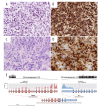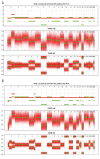Pediatric Soft Tissue Sarcoma in Limb-Girdle Muscular Dystrophy: Molecular Findings and Clinical Implications
- PMID: 39733240
- PMCID: PMC11694770
- DOI: 10.12659/AJCR.945715
Pediatric Soft Tissue Sarcoma in Limb-Girdle Muscular Dystrophy: Molecular Findings and Clinical Implications
Abstract
BACKGROUND Limb-girdle muscular dystrophy recessive 1 (LGMDR1) is an autosomal recessive degenerative muscle disorder characterized by progressive muscular weakness caused by pathogenic variants in the CAPN3 gene. Desmoplastic small round cell tumors (DSRCT) are ultra-rare and aggressive soft tissue sarcomas usually in the abdominal cavity, molecularly characterized by the presence of a EWSR1::WT1 fusion transcript. Mouse models of muscular dystrophy, including LGMDR1, present an increased risk of soft tissue sarcomas. However, the DSRCT risk and general cancer risk in patients with LGMD is unknown. Here, we delineate the clinical, molecular, and genetic findings of a patient with LGMDR1 who developed a DSRCT. CASE REPORT The patient was a boy who was diagnosed at the age of 9 years with LGMDR1, caused by the biallelic pathogenic variants NP_000061.1:p.(Arg448Cys) and NP_000061.1:p.(Thr184ArgfsTer36) in CAPN3. At 17 years of age, a pathologic soft tissue mass was found in the right pelvis. Immunostaining was positive for Desmin and negative for Myogenin and MyoD1, and RNA sequencing showed a EWSR1::WT1 fusion transcript, confirming the diagnosis of DSRCT. The patient relapsed after 1 year and, following a second relapse, he was started on palliative treatment. No germline variants in childhood cancer predisposition genes were detected by whole genome sequencing. CONCLUSIONS We describe a patient with LGMDR1 who developed a DSRCT. Since associations between LGMD and pediatric cancer are hitherto unknown, further studies are warranted, as little information is currently published about the pediatric cancer risk in this patient group.
Conflict of interest statement
Figures


References
-
- Angelini C. Calpainopathy. In: Adam MP, Feldman J, Mirzaa GM, et al., editors. GeneReviews® [Internet] Seattle (WA): University of Washington; Seattle: 2005. May 10, 1993–2024. [Updated 2022 Dec 1] Available from: https://www.ncbi.nlm.nih.gov/books/NBK1313/ - PubMed
-
- Liu W, Pajusalu S, Lake NJ, et al. Estimating prevalence for limb-girdle muscular dystrophy based on public sequencing databases. Genet Med. 2019;21(11):2512–20. - PubMed
Publication types
MeSH terms
Substances
LinkOut - more resources
Full Text Sources
Medical
Miscellaneous

